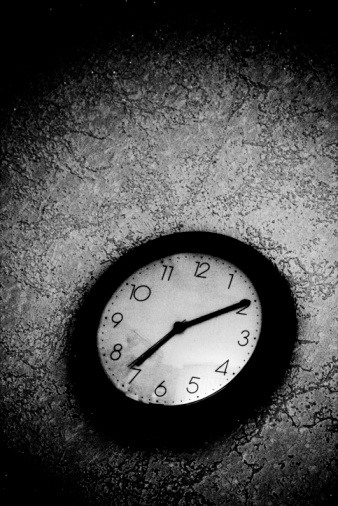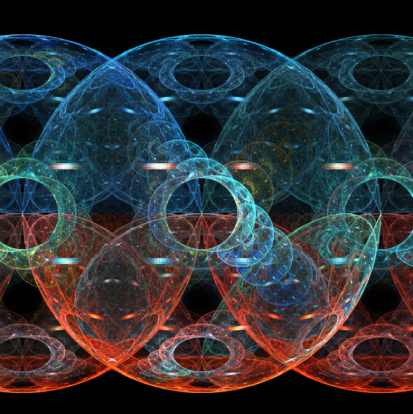The Temporal Community (Part 2)
By Asher Crispe: March 4, 2011: Category Decoding the Tradition, Inspirations
 Continuing with our reflection on the nature of community, we can pull back still deeper layers of connection between our sense of self or individual psychology and our participation in a collective identity on a sociological plane. The matrix of communal relationships becomes modified in kabbalistic analysis, wherein a person is encouraged to view ‘alterity within identity’ or sense ‘oneself as another.’
Continuing with our reflection on the nature of community, we can pull back still deeper layers of connection between our sense of self or individual psychology and our participation in a collective identity on a sociological plane. The matrix of communal relationships becomes modified in kabbalistic analysis, wherein a person is encouraged to view ‘alterity within identity’ or sense ‘oneself as another.’
This concept emerges out of the mathematical allusion appended to the initial teaching of Rabbi Nathan Shapiro—that the word tzibur (298), community, taken as a gematria, or numerical equivalent, equals the Hebrew word for rachamim (298), meaning compassion or ‘existential’ empathy. Here the other or others are inflected in the self.
In giving further thought to this idea, Marc-Alain Ouaknin (Concerto pour quatre consonnes sans voyelles, 271-272.) demonstrates how the kabbalistic notion of compassion is etymologically derived from the essence of feminine creativity. The root letters resh-chet-mem which form the word rachamim are present in the word for womb, rechem. Moreover, the yet-to-be of pregnancy within this womb highlights the indeterminate status of reality, a factor further illustrated by the encoded structure of this Hebrew root.
These component roots, in the hands of the kabbalists, can be likened to elementary building blocks that carry a specific and independent semantic charge, which can be permutated in any manner to yield other root constructions. One of these permutations is the word machar, mem-chet-resh, which means “tomorrow.” A tomorrow that is not today refers, in Ouaknin’s model, to the alterity of time. The physical other of the child carried within the womb of the mother is the opening within the center of one’s being, within the sphere of self-sameness. The space for the other as other, who is nourished by the self, is the symbolic function of the womb image. Compassion is making room for others by de-centering oneself and becoming other-centered.
Moreover, the alterity of time that exists within my particular sense of temporality provides the catalyst for associating the self with the other throughout the vicissitudes of time. Far from being the simple form of sympathy or identification, the “womb as compassion” comparison conjures up an image of radical substitution. What happens to this other person that I carry within also happens to me and vice versa. Altruism presents as a social ecology.
Consequently, one’s own sense of temporality—past, present, and future—facilitates the experience of alterity and leads to the community of those with nothing in common. According to Kabbalah, the aspect of the rasha (the negative or lawless state of being) corresponds to a person who is connected to the past (avar) [tense]. This specific sense of the past involves a kind of fatal determinism as if a person were feeling compelled to act according to a pre-set nature. This notion of the past (avar) is etymologically related to the word aveira which means transgression. Living in a manner that was fixed in the past is a transgressive state of being and an offense to the Divine. Similarly, the same root constructs the word averah meaning ‘passing by, a crossing or transition’ suggesting the fleeting character of the past. More positively, the root carries a connection to the concept of ma’evarah—a ford or transit—a crossing over (from the past) to the future.
Thus, the sense of the past referred to here—of having passed through all of life’s experiences—illustrates the notion of a negative state of being wherein there is no sense that the future can be substantially different from the past. Rather, the individual is stranded in a vicious unbreakable cycle where each day lacks the innovation of new life. This reflects a type of hard determinism as the subject falls fatally into a kind of Sisyphean existence. The absurdity of this situation is captured in the statement of the Talmud that “the wicked are considered as dead even within the context of their lifetimes.”
Thus, relative to the present and future modes of time, to be lost to the past, to be living in the past as the entirety of one’s consciousness, prefigures a person without a future and even without a real present. The self feigns progress all the while aware that this “nature”—be it personal or cosmic—is cast in stone. One’s self-awareness is one of rigid pre-determination.
With reference to the present tense, many of the medieval grammarians preferred the term “time of the intermediate” (zeman beinoni) rather than the convention of today which uses the term hoveh. The term beinoni displays a close kinship with the word bein which means simply “between.” The present is thus the temporal “between” caught at the intersection of past and future. Some have suggested that the present denotes more than this transitory state, referring to the duration of tension felt by the interaction of past and future as forces that continually act upon the present, giving rise to its character as the position of temporal conflict.
Life in the center, where time converges, carries two types of experience according to rabbinical sources: first, is the regenerative hypostasis—the subject contracts a renewed existence as part of the process of continual recreation asserted in kabbalistic cosmology; second, it is the sense in which the present stages the perennial conflict of the psyche. Here, the dialectical tension between ‘animal’ physicality—with all of the self-preservation instinct driving a person to remain the same—and the human spiritual capacity of transcendence—with all of the change brought forth from the future—serve to call oneself into question.
 Neither of these aspects can provide an exhaustive depiction of the present. In this model, they must be combined. The sandwiching of the subject in the “between” is epitomized by the continuous renewal of this conflict regarding personal change or remaining the same. Moreover, in the final analysis, the decisive factor rests on whether the individual will decide the present in favor of the past, that is, the back sliding into a repetition of previous behavior—the reality of the old—or embrace a future reality as the unfolding of the new, open in the opportunity to exceed this past.
Neither of these aspects can provide an exhaustive depiction of the present. In this model, they must be combined. The sandwiching of the subject in the “between” is epitomized by the continuous renewal of this conflict regarding personal change or remaining the same. Moreover, in the final analysis, the decisive factor rests on whether the individual will decide the present in favor of the past, that is, the back sliding into a repetition of previous behavior—the reality of the old—or embrace a future reality as the unfolding of the new, open in the opportunity to exceed this past.
Clearly, in so much as these moral or spiritual categories of past and present have been set down, the only possibility that remains for the future is to designate the time of the righteous (tzadikim). This allusion, built upon a hermeneutical play of grammar like the others, requires an additional interpretive step with the comparison of two Biblical verses. As a principle of transitivity (a=b), the first verse in the book of Proverbs (10:25), which states that the “righteous one is the foundation of the world” (tzadik yesod olam) is joined to another verse from the Prophets (b=c), “the mighty foundations of the earth” (vehaetanim mosdey aretz) (Micah 6:2). The common term, yesod or foundation, links the concept of the righteous with that of the mighty—in this case a specialized term reserved for the strength or steadfastness of the righteous. The resemblance between world and earth, which sets the context for revealing this strength of the righteous, is interpreted abstractly as the capacity to determine reality.
Thus, the righteous determine reality through the power of the word eitan which confers upon them a special strength. This word eitan is comprised of four letters alef, yud, tav and nun. These letters as a group possess a unique grammatical function as pronominal prefixes, for when any one of them is added to the beginning of a Hebrew verb, it transforms the tense of the word into the future. Thus, action becomes futural. The righteous, then, seem to hold the key to the future itself. The modesty of a pure future that has yet to appear on any horizon, which is not intelligible from the present, plays a pivotal role in determining the meaning of the present and even in recasting the past. Commenting on this sense of the future, the philosopher Emmanuel Levinas writes: “the future is open, one can therefore put in question the definitive quality of the past, which can receive at any time a new meaning…”(God, Death and Time, 99).
The implications of this model place the negative sense of the past as repetition, the present as the intermediate state of freedom to choose between past and future, and the future state as the anticipation of perfection. Can we not all say that we will be righteous in future? By adding a layer of axiology to the temporal divisions, this kabbalistic structure affirms the relativity of time.
As with a race against oneself, a person’s past, no matter how successful it appeared at the time, is now old, lacking interest and mechanical, relative to future potential. For example, a young child who is about to take his or her first step with the parents watching will cause great excitement. This, like all first-time record-breaking life achievements, draws a crowd. All enthusiastically applaud. Yet, only a short while has to pass before this same child progresses from effortless walking to running and jumping. We cease to be amused. No one is taking a picture of the five-year-old taking a step. The most astonishing achievement of yesterday ultimately belongs to yesterday and no longer stimulates us in the present. Thus, the past is past. It becomes a ‘transgression’ to live in the past, chained to reminiscence, devoid of inspiration and goals.
By contrast, the future has no fixed horizon. The more we chase it the more it flees from us. Perfection comes, yet not in some definitive time that would act like a finish line where upon crossing the game is over, mission accomplished. The future reflects an infinite process that we cannot fully anticipate. The future with, all its surprises, is the beyond-nature that re-fashions and re-determines nature, as the “righteous” one who, always accelerating towards the Infinite itself, maintains a course heading into the mystery of the unknown and unknowable.
Thus, to relate to the external other, to the many others with whom I have nothing in common, is conditioned by my sense of my own past as relative to my present state and future possibilities. Our uncommon commonality stems from the temporal mode of the individual’s past, regardless of his or her accomplishments. As if to say that the lack of similarity one has with this ‘type’ of person merges with the lack of similarity with one’s own past. Following this, the analogy of the “intermediate” or average member of the community—the beinoni—corresponds to one’s “present” situation, while identifying with the “righteous” person—the tzadik—defines one’s promise of the future that completes the comparison.
The psychology of temporal alterity in the subject greets and paradoxically unifies the social dissimilarities of any given communal context.
 In order to outline the next layer of temporal analysis for this model, we will have to evoke as a general principle of Kabbalah, the idea that all of reality displays the property of ‘interinclusion’ (hitkalelut). ‘Interinclusion’ suggests that attached to every detail of a given idea or experience, all other ideas or experiences must be discernible within its inner dimensions. In other words, kabbalistic models are organic. Structurally, they behave holographically wherein each part contains the entire picture within its inventory.
In order to outline the next layer of temporal analysis for this model, we will have to evoke as a general principle of Kabbalah, the idea that all of reality displays the property of ‘interinclusion’ (hitkalelut). ‘Interinclusion’ suggests that attached to every detail of a given idea or experience, all other ideas or experiences must be discernible within its inner dimensions. In other words, kabbalistic models are organic. Structurally, they behave holographically wherein each part contains the entire picture within its inventory.
Therefore, when ‘interincluded’, the three dimensions of time—past, present, and future as the rasha, beinoni and tzadik—become nine levels in a more matured set of reflections. These nine levels refer to the past, present, and future within the past—past, present, and future within the present—and past, present, and future within the future.
Though only implied, this kabbalistic principle would seem to suggest that the past has three distinct modes. We might speculate that the past of the past would be the pure past as though dead and unalterable if not irretrievable. The present of the past would consist of memory in which the facts remain unchanged for the one who wishes to remember things just the way they were. The future of the past is the opening of a closed chapter in a book in order to revise it. This position reflects the capacity of present and future experience to modify and amend the past as a revisionist historian to one’s ongoing autobiography.
As for the present, the past within the present is the weight of one’s history and all the baggage of one’s personal experience that hinders the freedom to enjoy the freshness of the present unencumbered. The present of the present is the pure experience of re-creation as both the self and world are forged anew. For the human subject, this power is internalized psychologically as the personal assertion of one’s right to change oneself even to the point of a full existential makeover. As for the future in the present, this is opportunity calling—the promise of that which exceeds the conservation of energy in the current system.
Over the horizon, for the past within the future—would this not refer to the resurrection of the dead, an event marked by the Sages as part of the future to come? This stage would seem to reflect a kind of conservation of all life and life experience—the ultimate preservation of the past in its entirety for the future in the denial of the possibility of loss. Significant experiences must endure. The meaning of life outlasts the length of life if it is continually retrievable. By extension, all recollection is in fact a resurrection of the dead.
The present within the future as the messianic age would focus collective consciousness on the continual presence of the future. To put it differently, the self-evident state of ascent, of progress without regress, would be the promise of this temporal mode. Finally, the future of the future is hinted at in the statement of the sages as the time which “no one has seen except you God” (Isaiah 64:3). Termed the “future to come,” this future is the alterity that eludes even the vision of prophecy.
Consequently, we find that everyone and everything has an appointed time as well as an appointed network of temporal relations. Through the power of time to give definition and redefinition to both self and other, to individual and community, we have come to discover that, in the words of Franz Rosenzweig in his work, The New Thinking: “the tenses of reality are not interchangeable. Just as every single event has its present, its past, and its future, without which it is not discerned, or only distortedly, so it is with reality as a whole.”
The Temporal Community (Part 2),






















;)
;)
;)
;)
;)
;)
;)
;)
;)
;)
